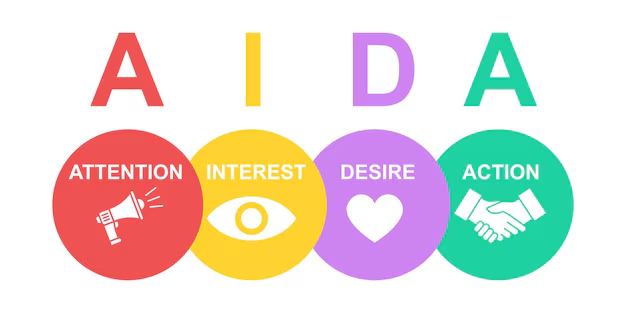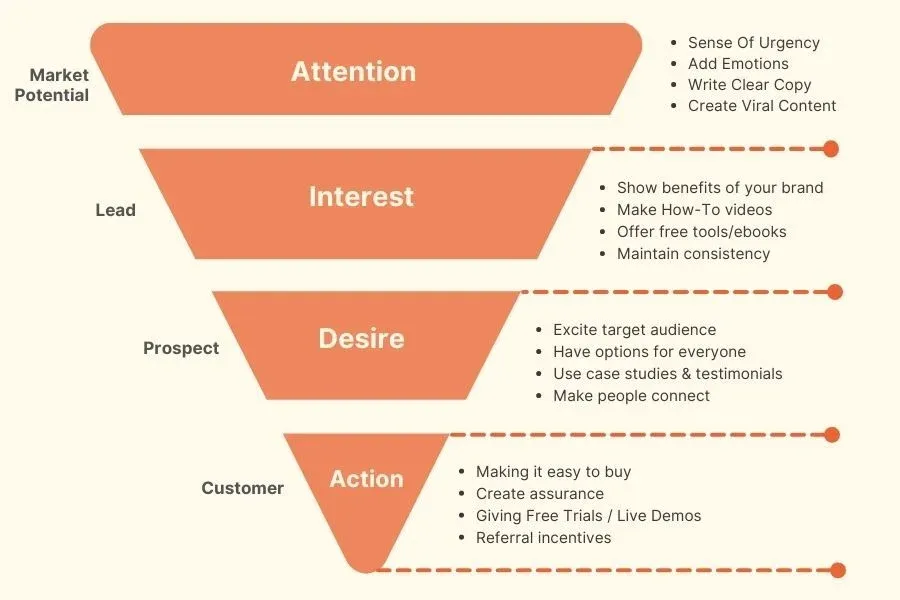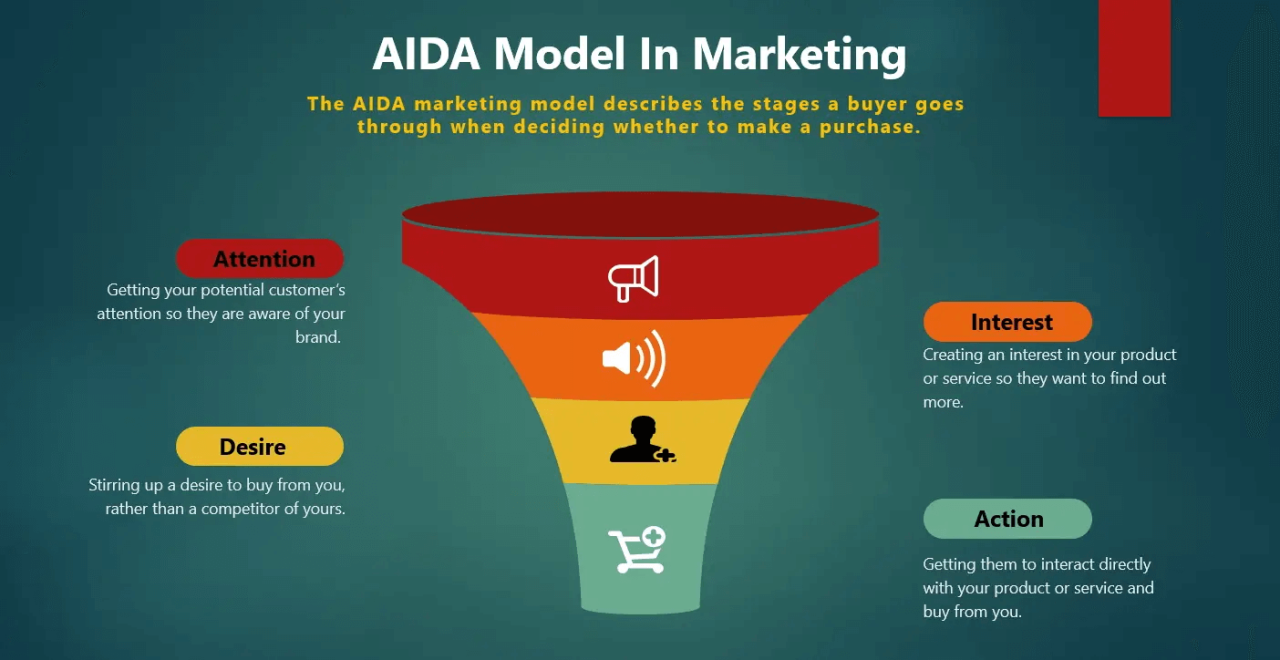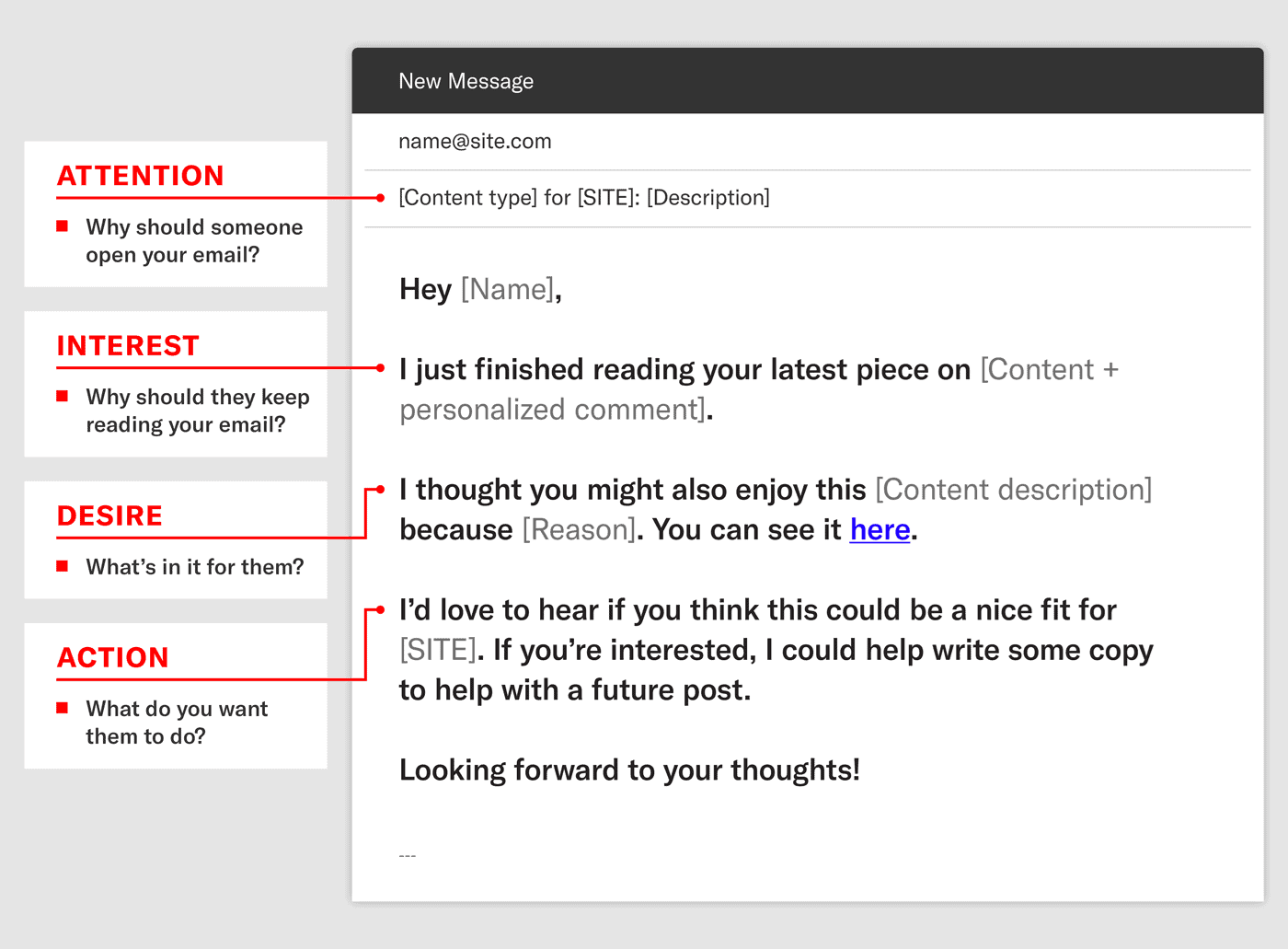What is the AIDA model in Marketing? How to apply it? The AIDA model is being widely applied in most Marketing strategies . Because AIDA represents almost the entire psychological development of the target customers that the business is targeting. Let’s learn more about the AIDA model in Marketing with MarkKnow in the article below!

What is the AIDA Model in Marketing?
It can be understood that the AIDA model is a prominent theoretical framework in the field of Marketing, used to analyze and describe the journey that customers go through when approaching a product or service. This model was formed in the early 20th century and still retains high applicability in modern Marketing campaigns.
To better understand AIDA, you can refer to the following example:
Customers are looking for watches and your website is in the top 1 position. Customers are attracted by the attractive, stimulating title, forcing them to click on the website to read the information. When customers visit the website, they feel interested and impressed with your company’s message. Although at that time they have not made a purchase decision, they have shown signs of interest in your company’s products.
On a special occasion, your company sends a more convincing message to reach that customer again. Finally, a discount code for the customer to make a decision to buy the product. That is the AIDA Marketing Funnel model.
This method is quite effective if businesses apply it at the right time and to the right customers.
Origin of the AIDA Model

According to research, the theory of the AIDA model was first proposed by E.St.Elmo Lewis – an American advertiser and salesman. He proposed 3 principles for a successful advertising campaign as follows: “The task of an advertisement is to attract the reader so that he sees and begins to read it; then interest him, so that he continues to follow it; and finally convince that person so that after reading the advertisement, he will believe it. If a marketing campaign has all three of these successful qualities, it is a successful advertisement”.
Then, around late 1899 and early 1900, in an advertising contest organized by the Bissell Carpet Sweeper Company (USA), the contestants’ entries were evaluated based on the following criteria:
- Ads must get “Attention”
- Once it gets attention, it has to create “Interest” in the viewer.
- This interest must then stimulate a “Desire to Buy”
- Desire to buy leads to “Decision” to buy
It was not until 1921 that the concept of the AIDA Model was officially formed by CP Russell. And now, AIDA is increasingly being applied in modern life.
Advantages of AIDA Model
The AIDA model is chosen by many businesses to apply in 4P Marketing because of the following outstanding advantages:
Clear Structure
The AIDA model in Marketing provides a coherent structure of four stages: Attention, Interest, Desire, and Action. This structure helps Marketers easily track the customer journey and organize content logically. Each stage corresponds to a specific goal, helping businesses easily develop strategies to achieve that goal.
Customer Focus
One of the biggest advantages of AIDA is its emphasis on understanding the needs and psychology of customers. Each stage in the model requires businesses to consider how customers think and feel. This promotes the development of marketing messages that customers feel close and familiar with, thereby strengthening the connection with the brand.
Easy to Implement
The AIDA model can be applied to many different forms of marketing, including television advertising, email marketing , social media content, and direct campaigns. This flexibility allows businesses to tailor the model to their specific needs and apply it in many different contexts.
Encourage Creativity
The AIDA model in marketing not only provides guidance but also encourages marketers to think creatively. By focusing on each stage, they can develop unique and engaging content, from ads to blog posts. This creativity not only attracts customers but also creates a positive impression of the brand.
Easy to Measure
The AIDA model provides a framework for measuring the performance of marketing campaigns. KPIs can be set for each stage, making it easy for businesses to track customer progress and identify which stages need improvement. This allows businesses to optimize their budgets and increase the effectiveness of future campaigns.
The Role of the AIDA Model in Marketing
The AIDA model is an important tool in Marketing, helping businesses optimize marketing strategies and build deep relationships with customers.
Identify the Interaction Process
The AIDA Model in Marketing defines the customer journey from the moment they first become aware to when they make a purchase. It breaks down the interaction process into four stages: Attention, Interest, Desire, and Action. This allows businesses to clearly visualize the steps customers go through and adjust their marketing strategy at each point to enhance the experience and increase the likelihood of conversion. Through this, businesses can clearly understand the complexity of the customer’s decision-making process, from initial curiosity to when they actually take action.
Create a Marketing Strategy
AIDA is a powerful tool that businesses can use to build a comprehensive marketing strategy with a clear structure. At each stage of the model, businesses will use different approaches, aiming to achieve specific goals: attract initial attention through creative advertising, maintain interest with informative content, stimulate the desire to buy the product through outstanding benefits, and finally create a strong call to action. Thanks to AIDA, the marketing strategy becomes coherent, easily adjusted based on customer response at each stage.
Create Effective Content
The AIDA Model in Marketing serves as a guide for creating marketing content according to each stage of customer interaction. In the Attention stage, the content must be creative, attractive and quickly impressive. In the Interest stage, the content needs to be detailed and provide useful information to retain customers. In the Desire stage, the content must focus on stimulating needs, convincing customers that the product will benefit them. Finally, in the Action stage, the content needs to create a clear, convincing call to action, motivating customers to make a purchase.
Increase Advertising Effectiveness
AIDA-based advertising is optimized to guide customers through each stage of the buying journey. While in the Attention stage, ads are designed to make a quick impression with a prominent image or message, in the Interest stage, ads need to keep customers interested by providing information or reasons for customers to learn more. Next, businesses need to emphasize the specific benefits that the product or service brings to stimulate the desire to buy. Ads that motivate customers to take action by creating a sense of urgency or offering attractive incentives will be promoted in the final stage, Action.
Performance Measurement
The AIDA Model in Marketing provides a logical framework that helps businesses easily measure the effectiveness of each stage in a marketing campaign. Each stage (Attention, Interest, Desire, Action) can be tracked with specific metrics such as impressions, interactions, or conversion rates. This helps businesses analyze the performance of their marketing campaigns in more detail, thereby adjusting strategies or optimizing content to achieve better results. Measuring each stage not only helps improve marketing effectiveness but also provides important information about customer behavior.
Create Deep Connections
In addition to helping businesses promote shopping behavior, the AIDA Model in Marketing also facilitates building deep relationships with customers. By understanding and meeting customer needs at each stage, businesses can create sustainable connections. Initial attention and interest will lead to customers clearly recognizing the value of the product, thereby developing desire and loyalty. Moreover, with each purchase action, businesses can build long-term relationships by continuing to provide value and maintaining post-sale interactions. It can be said that applying the AIDA model is also a way to help businesses do effective Branding Marketing.
Four Stages of the AIDA Model in Marketing

The AIDA model in Marketing will be implemented in the following stages:
A – Attention (Attracting Customers)
This stage focuses on capturing the attention of customers amidst a sea of marketing messages. In a world full of information, it is important to make your product or service stand out from the crowd. Businesses often use impressive elements such as sensational headlines, eye-catching images, and compelling stories to attract attention. Steve Jobs once said, “Innovation distinguishes between a leader and a follower.” Attracting attention is not just about advertising, but also creating a reason for customers to be curious and want to learn more.
I – Interest (Arouse curiosity and interest in customers)
After attracting attention, the next step is for businesses to retain customers by arousing their interest. In the Interest stage, businesses need to provide valuable content, answer questions or solve problems that customers may encounter. Presenting useful information about a product or service will help customers feel excited and want to learn more. Methods such as providing detailed product descriptions, instructions for use or giving real-life examples of product benefits can all be applied to increase interest and retain potential customers.
D – Desire
The Desire stage is the next step, when businesses move from generating interest to stimulating customers’ need to buy. At this stage, businesses need to create a feeling that their product or service can satisfy a specific need or desire of the customer. Advertising or marketing content will focus on specific benefits, the superior values that the product brings. Factors such as uniqueness, special features, high quality, positive reviews from users will help increase the desire to own the product from the customer, making them feel that they need the product to solve their problems.
“We are what we repeatedly do. Excellence, then, is not an act, but a habit” – Aristotle’s philosophy suggests that desire comes not just from short-term persuasion but also from long-term belief in the value of the product. This stage aims to turn interest into desire, creating a feeling that the customer really needs the product to improve their life.
A – Action (Making Decision)
Finally, when the desire is strong enough, businesses need to motivate customers to take action, usually to buy the product. This is when they make a decision. Businesses need to make it easy for customers to take this action by providing clear, accessible information, which can be encouraged through incentives, discounts, or urgent messages such as “buy now.”
Napoleon Hill once said, “Do not wait; the time will never be ‘just right.’ Start where you stand, and work with whatever tools you may have at your command” – driving action at the moment of decision is the core of marketing success.
How to Apply the AIDA Model in Effective Marketing
There is only one AIDA model in Marketing, but the way to apply this model to businesses is different. So what should you do to be most effective?
During the Attraction Phase
Businesses should research the emotions of their target customers. Next, they need to create quality content that solves all the problems customers are facing. At the same time, they must appeal to the psychology and emotions of customers. Specific methods include:
- Social Media Advertising: Use high-quality images, videos along with attractive headlines to create an immediate impression. Using dynamic or carousel ad formats on platforms like Facebook, Instagram… can increase engagement rates.
- SEO and Content Marketing: Optimizing keywords in blog post content makes it easier for users to find information when they search on Google. Valuable, optimized content will not only attract attention but also keep readers on your site longer.
- Video Marketing: Using short, engaging videos, especially entertaining videos or videos with strong messages, will have a high ability to attract attention. Video ads on YouTube, TikTok… with creative, unique content can quickly create a strong impression.
- Email Marketing: Attention-grabbing, friendly email subject lines can generate high open rates. Use emojis or questions that spark curiosity to encourage recipients to open and read the content inside.
During the Attraction Phase
According to the AIDA model in Marketing , when customers are attracted to your product, they will tend to learn more about issues such as: Brand, benefits received, etc. To approach and solve problems for customers, you need to declare your mission on the website, explaining exactly and fully what you are doing.
- Provide Useful Content: Create detailed articles, guides, videos explaining the product, how to use it, and specific benefits. This content not only helps customers understand the product but also builds trust in the brand.
- Share Your Brand Story: Storytelling is a powerful tool for connecting emotionally with customers. Telling stories about how your product has helped consumers or the challenges your brand has overcome helps customers feel closer to your brand.
- Use Social Proof: Provide customer reviews, testimonials, or case studies. Having real consumers share positive experiences will increase interest from new customers, creating a sense of trust and security.
- Direct Interaction: Encourage users to comment, ask questions or participate in surveys on social networks and forums. This interaction not only retains customers but also helps businesses better understand their needs.

In the Customer Desire Promotion Phase
To motivate customers to take action, you need to make sure that their interest has reached a certain level. To achieve that, you need to provide your website with useful information. When customers interact more, they will trust your brand more. From there, their ability to buy also increases a lot.
- Create Compelling Incentives: Discounts, promotions, or giveaways can increase desire for a product. For example, “buy 1 get 1 free” offers or discounts on first purchases are often effective.
- Emphasize Unique Benefits: Highlight the unique features or value your product offers. Using images and text to clearly illustrate these benefits can create a powerful appeal.
- Share Customer Experiences: Use videos or articles from previous users to help future customers better visualize a positive experience. Real-life success stories are often powerful.
- Build a Sense of Scarcity: Announcing that a product is in limited quantities or that the offer is only available for a short time creates a sense of urgency, making customers feel they need to act now so they don’t miss out.
During the Action Promotion Phase
In the final action-driven stage, you should encourage your customers to make a purchase in the following ways:
- Clear Calls to Action: Use “Buy Now,” “Sign Up Now,” or “Get Deal” buttons to direct customers to a specific action. These calls should be prominent and prominent.
- Provide an Easy Shopping Experience: Make sure the checkout process is simple, clear, and user-friendly. Checkout steps should be optimized to minimize cart abandonment.
- Follow Up and Reminders: Use reminder emails for customers who abandoned their carts or showed interest but did not purchase. These emails should be personalized and may include incentives to encourage customers to complete the transaction.
- Encourage Sign-ups or Participation: Give customers the opportunity to join loyalty programs or sign up for newsletters to stay in touch. This not only strengthens the relationship but also opens up opportunities for future sales.
Understanding the Extended AIDA Model
The AIDA model in Marketing has been improved and expanded with many different variations, such as:
- Acknowledge – Learn: Customers learn about brand elements, such as size, color, price, availability, etc.
- Liking: Customers perceive some positive benefits associated with the brand.
- Preference – Priority: Consumers give priority to buying a business’s products over competitors.
- Conviction: Convince customers who are interested in the product but have not yet converted to purchase behavior.
- Satisfaction: Provide after-sales services to maintain loyal customers for the business. At the same time, Marketers need to survey customer satisfaction with the quality of products and services provided by the business through customer care channels.
Comparison of AIDA and AISAS Models
The AIDA model in Marketing and the AISAS model are both models that focus on exploiting the customer journey. However, these two models have differences, specifically:
| Element | AIDA Model | AISAS Model |
| Define | AIDA is a model that describes the customer’s buying journey from awareness to purchase. | AISAS is a model that describes the customer journey from information search to purchase, focusing on information sharing. |
| Structure | Attention → Interest → Desire → Action | Attention → Interest → Search → Action → Share |
| Concentrate | Focus on leading customers to purchase action. | Focus on encouraging customers to search for information and share their experiences. |
| Search Phase | There is no specific stage of information search. | The information search stage is very important, emphasizing the use of search engines. |
| Sharing Phase | There is no information sharing phase. | The sharing stage allows customers to share experiences and information about the product, creating social interaction. |
| Application | Often used in traditional advertising and marketing campaigns. | Suitable for online marketing, especially in social media and e-commerce environments. |
| Strategy | Emphasis on convincing and converting customers. | Emphasis on creating shareable content and increasing social engagement. |
| Target | Drive immediate purchase action. | Encourage searching and sharing information before and after purchase. |

Some Notes When Applying the AIDA Model
To be able to apply the AIDA model in Marketing most effectively, you should avoid the following mistakes:
Don’t Focus on Just One Part
Some businesses may focus on only one stage of the AIDA model in Marketing, such as focusing only on attracting attention and ignoring the following stages. This can lead to customers not being motivated to move further in the shopping journey. When the stages are not fully developed, customers may feel uninformed or not convinced enough to make a purchase. As a result, the conversion rate will decrease. Therefore, you must ensure that each stage is developed synchronously, closely linked together, creating a smooth journey from one stage to the next to lead customers to action.
Each Part of the AIDA Model Must Achieve a Standard Level
Sometimes, businesses may be implementing parts of the AIDA model superficially or not strongly enough. For example, the content in the “Interest” stage is not compelling or clear enough, causing customers to lose interest. If one part is not up to the mark, the entire process can be affected. Customers can quickly lose interest and abandon the purchase journey. What you need to do is evaluate and improve each part of the AIDA model in Marketing meticulously, ensuring that each stage is performed with high quality, bringing value to customers.
Title and Content Must Be Consistent
A common mistake that many businesses make is using an attractive title but the content is inappropriate or irrelevant. This can make customers feel deceived or not fully informed. When the title does not match the content, customers can feel disappointed, distrustful of the brand, leading them to abandon not only the product but also the brand. Therefore, when applying the AIDA model in Marketing, you must ensure that the title and content are consistent. The title should accurately reflect the content that the reader will receive, helping to build trust and confidence from the customer.
Understand Your Audience
Businesses need to segment the market to identify specific customer groups, thereby reaching them more effectively. This includes researching demographic factors such as age, gender, income and education level, thereby building a clear picture of the target audience. At the same time, analyzing shopping behavior and consumer habits is also very important, because it helps businesses grasp how customers interact with their products and services. Understanding the psychology and values of customers will contribute to creating appropriate messages, increasing the ability to attract and retain customers.
Building Relationships
Continuous communication with customers is an important factor in building and maintaining relationships. Businesses should use Email Marketing to send periodic information about new products, promotions or related news, keeping customers updated. In addition, quick interaction on social networking platforms is also essential, because it not only helps answer questions but also creates a sense of closeness and friendliness with customers. When customers feel cared for and listened to, they tend to be more loyal to the brand.
Successful AIDA Model Examples
Currently, many businesses have built success through applying the AIDA Model in Marketing, including:
Netflix
- Attention: Netflix attracts customers’ attention by using eye-catching images, engaging advertising content on social media platforms along with outstanding TV advertising campaigns. Unique movie posters, exciting trailers have helped attract a large number of viewers.
- Interest: Once it has captured attention, Netflix builds interest by offering high-quality movies and TV shows tailored to each audience’s interests. Features like “Watch Next” and “Recommended for You” based on viewing history help keep users engaged for longer.
- Desire: Netflix creates desire by introducing exclusive content like popular series like “Stranger Things” and “The Crown.” Not only is this content exclusive, it’s also so well-crafted that viewers feel the need to experience it immediately.
- Action: Finally, Netflix encourages action by offering flexible subscription plans and incentives for new users, like a one-month free trial. This helps lower the barrier to entry, encouraging users to sign up immediately.
Coca-Cola
- Attention: Coca Cola always uses cheerful images and bright colors in its advertising campaigns to attract attention. Creative advertisements during major events such as the World Cup or Christmas have attracted strong public attention.
- Interest: The company creates interest through interactive campaigns, such as the “Share a Coke” campaign where consumers’ names are printed on the bottles. This not only stimulates curiosity but also encourages consumers to seek out bottles with their or their friends’ names on them.
- Desire: Coca-Cola evokes desire by associating the product with happy, joyful moments in life. The advertisements often evoke fond memories of enjoying Coca-Cola with family and friends.
- Action: Finally, Coca-Cola encourages action by offering multiple distribution channels, allowing businesses to buy products everywhere, from convenience stores to supermarkets. They also regularly have attractive promotions to stimulate shopping demand.
Francesco Group
- Attention: Francesco Group – a hair salon chain has attracted attention by using high-quality images, tutorial videos on social media platforms. They also organize events, fashion shows to attract public attention.
- Interest: They create interest by sharing beauty tips, new trends in the hair industry, helping customers feel connected and interested in their products and services.
- Desire: Francesco Group stimulates desire by introducing exclusive services, high quality hair care products. They regularly update promotions or special discounts for new services.
- Action: Finally, they encouraged action by creating an easy online booking system, along with incentives for first-time customers. This increased booking rates and customer retention.
It can be seen that the AIDA model in Marketing brings many advantages to businesses today. However, to apply it effectively, you need to really understand AIDA. Hopefully, the information shared in this content will be helpful to you.
Frequently Asked Questions
Where Can the AIDA Model Be Applied?
The AIDA Model can be applied in many areas such as Digital Marketing services, social media, Email Marketing and any activity related to sales or communication with customers.
How to Measure the Effectiveness of the AIDA Model?
Businesses can track KPIs for each stage, such as click-through rate (CTR) for the attention stage, engagement time for the interest stage, conversion rate for the action stage.
What Are Common Mistakes When Applying the AIDA Model?
Some common mistakes include: Focusing on only one part of the model, inconsistent content between stages, lack of personalization and connection with customers…
Can the AIDA Model Be Combined With Other Models?
Yes, the AIDA model can be combined with other Marketing models such as AISAS (Attention, Interest, Search, Action, Share) to create a more comprehensive Marketing strategy.
Who Should Use the AIDA Model?
The AIDA model can be used by anyone in Marketing, Sales, or anyone who wants to better understand the customer journey, including entrepreneurs, marketers, analysts.
What Resources Are There to Learn More About the AIDA Model?
There are many resources like books, blog posts, video tutorials, online courses on Marketing and the AIDA model that you can look up to expand your knowledge.
Comment Policy: We truly value your comments and appreciate the time you take to share your thoughts and feedback with us.
Note: Comments that are identified as spam or purely promotional will be removed.
To enhance your commenting experience, consider creating a Gravatar account. By adding an avatar and using the same e-mail here, your comments will feature a unique and recognizable avatar, making it easier for other members to identify you.
Please use a valid e-mail address so you can receive notifications when your comments receive replies.
